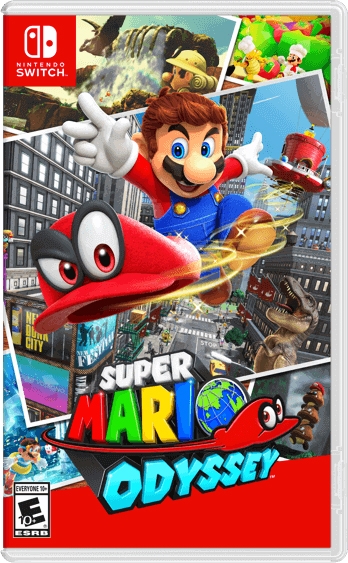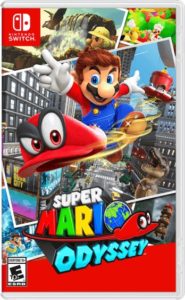

The more open structure of ‘Odyssey’ has invited comparisons to ‘Super Mario 64’, one of the most critically-acclaimed games of all time.
Zach Landau | A&E Editor
11/02/17
You know, one would think that after being burned twice before, I would learn not to get excited for Mario games. You would think.
But by George, I got excited for Super Mario Odyssey. After Breath of the Wild did the unthinkable and jettisoned the tired, exhausting formula of the Zelda series for the tired, exhausting formula of Western RPGs, a vague sense of hope started blooming within me. Perhaps, I began to think, Nintendo will finally make a Mario game that doesn’t feel like an afterthought, a game that returns to absolutely sublime controls and drops the ridiculous pretense that slapping the Italian’s face on any old garbage is good enough.
Nearly the past decade, save the original Galaxy, has been the worst time to be a Mario fan. So when the reviews for Odyssey started emerging from the woodwork, all claiming that Mario has finally returned to the formula of 64 and Sunshine, my little light of hope ignited to a full-fledged fire, and I bought the game day one.
Only to be disappointed. Again.
Admittedly, Odyssey is far better than any Mario game from the past decade, even possibly beating out the, again, stupendous Galaxy. However, it is most certainly not a return to form for Nintendo’s flagship property, but a sort of reboot that makes allusions to its forefathers without actually evolving their work.
What do I mean? Well, let’s start with the controls.
Despite pumping roughly 30 hours into Odyssey, I still cannot come to grips with how the plumber handles. Mario’s momentum is virtually non-existent; pressing forward on the control stick will cause the plumber to lurch forward and reach his terminal velocity nearly instantly. Running down hills and slopes will temporarily increase his running speed, but this increase feels more like a switch being turned on than a gradual shift into faster and faster speeds. The same can be said for the new rolling mechanic, a feature that allows Mario to move just a bit faster, but only — and infuriatingly — a bit. Rather than speed being a reward for well-timed jumps and dives (or splashing a little water in front of you to make an impromptu Slip-n-Slide), it is a mode, a state of being almost, that players can activate with a press of the button.
Speaking of, the options in the game are admirable compared to past entries in the series but still sorely lacking. Odyssey uses only three buttons — Y/X, A/B and ZL/ZR — and credit where credit is due: it is impressive that the game can accomplish so much with such a simplified control scheme. However, this basic setup begs the question as to why players cannot customize their controls. Cramming in the Y button while also trying to press B and trying to move both control sticks to land a tricky jump is not ideal. This is to say nothing about the accessibility issue. If two face buttons can be dedicated to jumping, why can’t we change one of them to the crouch button? Hopefully this will come later down the line, but the fact Odyssey launched without a feature that is virtually standard in the gaming space is absurd.
The actual layout of Odyssey is also disappointing. Rather than being mission-based, the majority of the collectable dujour this time around — Power Moons — are scattered across mid-sized maps in weird and interesting locations. Players can stumble across a Moon under a pile of garbage, or maybe hidden in a piece of the level’s architecture, and a number of other interesting places. Earning Moons definitely feels exciting at times, with some hiding behind some genuinely difficult or clever challenges, but the sheer amount of them, as well as how easy it is to happen on a lot of them, sucks a lot of the fun out of the experience. While Power Stars from games past felt momentous as great rewards for completing missions, Moons feel virtually useless in comparison. Beating a boss or overcoming a platforming section feels less significant when you collect five times the reward by accident on the way to completing the challenge.
This is to say nothing about those challenges themselves. Odyssey can’t shake the shackles of Mario games past, and the reuse of boss fights not once, but twice, was severely disappointing. Many Power Moons do not even require platforming but are Capture challenges. Capturing enemies (and other objects, but I only have so many words) is the new gimmick that Odyssey introduces to the series, and it’s fine. Just OK, really. While Capturing is an exciting feature at first, it quickly loses its charm as the challenge of the game shifts from actual running and jumping to lock and key puzzles. See an unlit torch? Capture a Fire Bros. See a Goomba wearing a red hat? Capture another Goomba and start stacking the little mushroom freaks.
Actually, quick tangent: I honestly can’t stand Peach in this game. Once again relegated to the role of helpless victim, it was absolutely
infuriating to watch her do absolutely nothing throughout the entire game. Maybe I like the Peach from the Mario RPGs too much, but even in Galaxy she would send assistance in the form of lives. And I don’t think I would be so upset about it if it wasn’t for Tiara, Peach’s personified headpiece that is also a damsel in distress.
Oh, and Nintendo wants you to definitely know that Tiara is a girl. This is of utmost importance to the company because in no way, shape or form do they want to give the impression that a piece of clothing can be associated with anyone of any gender, and that it is the role of boy hats to save the girl ones.
Anyway.
There is a lot more that can be said about Super Mario Odyssey, but to conclude this 1000-some word review, let me just emphasize that is by no means a bad game. Were it to come out 15 years ago, I would have ranked it among the best ever produced. However, to pretend like Odyssey is the triumphant return for Nintendo’s iconic hero is honestly a testament to just how dire the past few years have been for his fans. Odyssey certainly does better than before, but better does not account for much when the actual product is passable at best.



